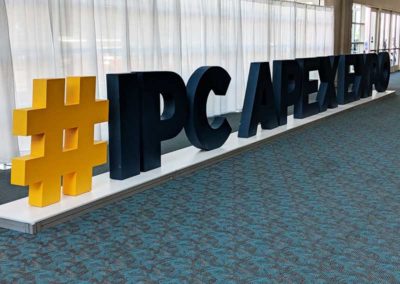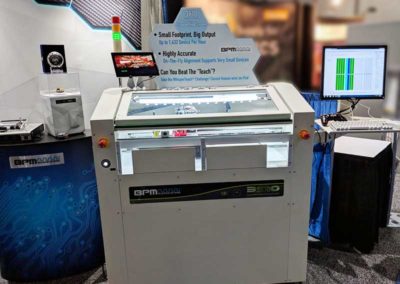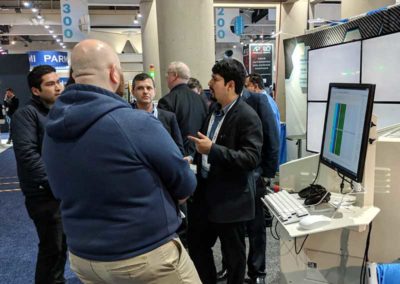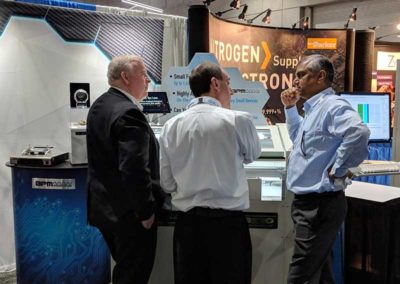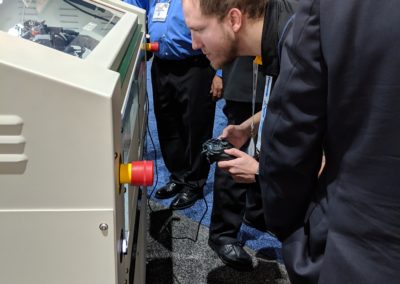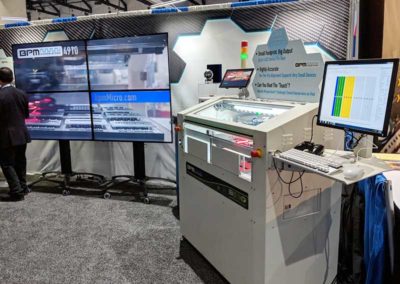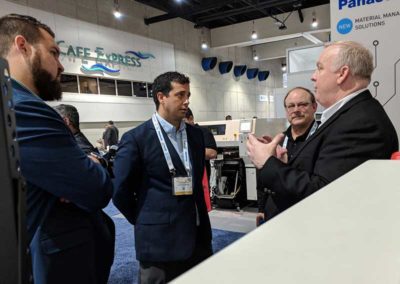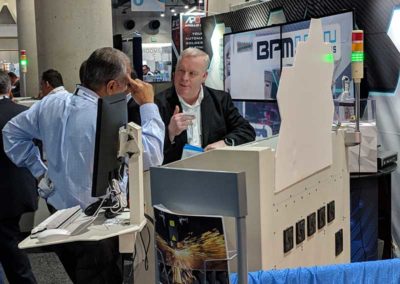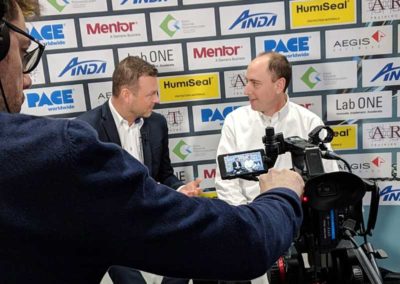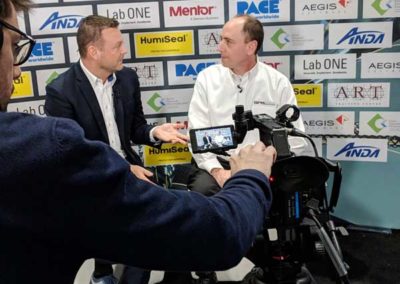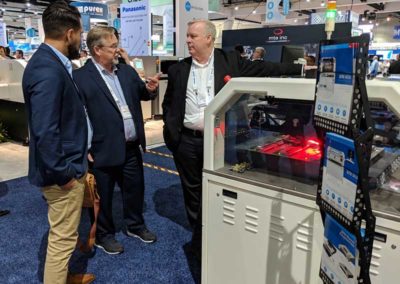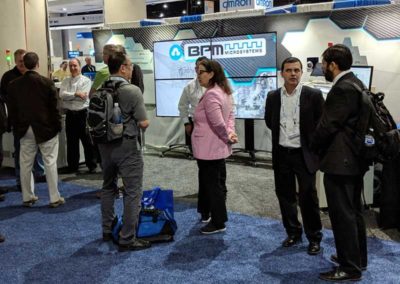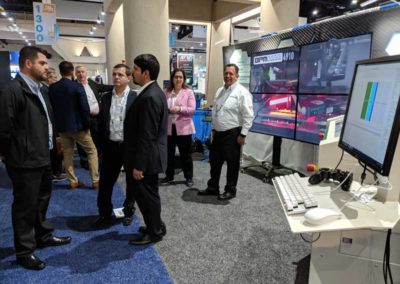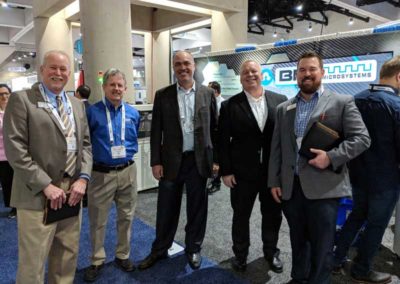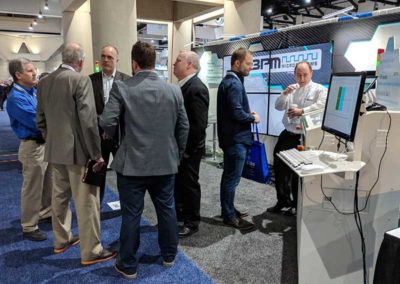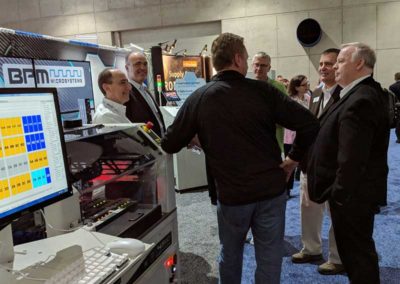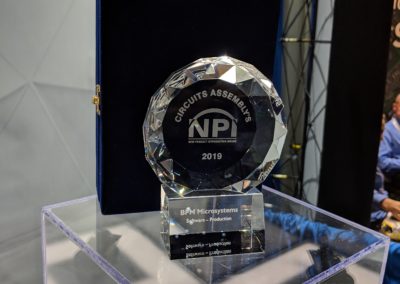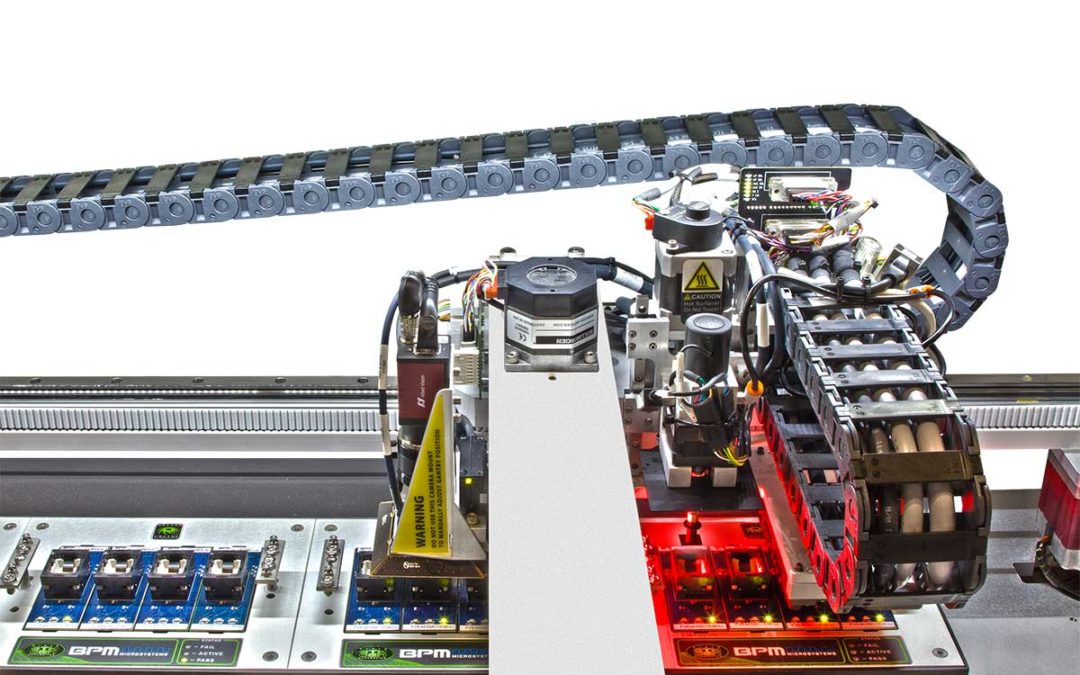
by Scott Bronstad | Mar 18, 2019 | Announcements, News
BPM Microsystems finished 2018 with 55% year-over-year sales growth for automated programming systems. “We’re pleased with how the marketplace has embraced our automated systems,” said William White, Founder and CEO at BPM Microsystems. “We launched two major upgrades last year: the 3910 and the 4910. Both the machines exceeded their predecessors and helped fuel an increase in our market share. They excel in speed, ease of use, and lower cost of ownership.” BPM ended the year with an overall sales growth of just under 20% (compared to 2017).
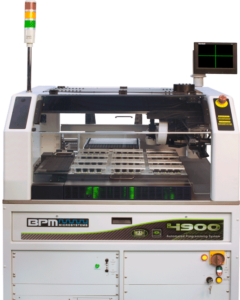
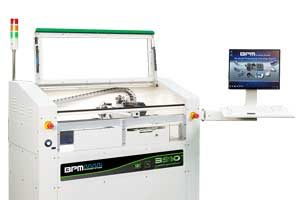 BPM launched two major product enhancements in 2018 with the 3910 in September and the 4910 in November at Electronica in Munich, Germany. The 3910 and 4910 feature WhisperTeach, the award-winning Z-Teach hardware/software that delivers faster set-ups, better accuracy, and repeatable high-quality programming, critical for modern devices. The machines also received a major increase in speed: The 3910 is rated at 1,432 Devices per hour with up to 16 sockets (44% faster than the 3900), while the 4910 delivers 1,708 DPH with up to 48 sockets (almost 30% faster than the 4900).
BPM launched two major product enhancements in 2018 with the 3910 in September and the 4910 in November at Electronica in Munich, Germany. The 3910 and 4910 feature WhisperTeach, the award-winning Z-Teach hardware/software that delivers faster set-ups, better accuracy, and repeatable high-quality programming, critical for modern devices. The machines also received a major increase in speed: The 3910 is rated at 1,432 Devices per hour with up to 16 sockets (44% faster than the 3900), while the 4910 delivers 1,708 DPH with up to 48 sockets (almost 30% faster than the 4900).
BPM’s proven 4000 series handlers have more than proven their reliability with hundreds of installations worldwide with many systems still in 24×7 operation after more than 16 years. BPM’s proven 9th Generation Programming Sites deliver the fastest and most universal programming site technology in the market. BPM’s global service and support network serve the demanding requirements of mission-critical installations across six continents.
See the original press release here

by Scott Bronstad | Mar 12, 2019 | Announcements, News
BPM Microsystems Expands Executive Management Team, Adds Global Sales Consultant
 BPM Microsystems is pleased to announce the addition of Don McMahan as their Global Sales Consultant. McMahan has a history of successfully growing sales through channels for companies large and small and was named one of CRN’s Top Channel executives four years in a row. “I am thrilled to join the management team at BPM, a company with a long legacy of delivering leading-edge solutions to some of the largest programmable semiconductor users in the world. It’s also very rewarding to join a US manufacturer that can compete on the world’s stage,” says McMahan.
BPM Microsystems is pleased to announce the addition of Don McMahan as their Global Sales Consultant. McMahan has a history of successfully growing sales through channels for companies large and small and was named one of CRN’s Top Channel executives four years in a row. “I am thrilled to join the management team at BPM, a company with a long legacy of delivering leading-edge solutions to some of the largest programmable semiconductor users in the world. It’s also very rewarding to join a US manufacturer that can compete on the world’s stage,” says McMahan.
“I am excited to announce that Don McMahan has joined the BPM Microsystems management team as the Global Sales Consultant this week, helping all of us climb to new levels,” says William White, Founder and CEO of BPM Microsystems. “I look forward to having Don help us refine our sales strategy, improve our sales processes, and to be an important resource to assist our sales team and our partners continue on the growth curve BPM Microsystems has been tracking to for more than 30 years.”
Mr. McMahan has nearly 40 years of senior sales management experience managing the Americas for a number of large technology companies such as Eastman Kodak, Fujitsu, and Hitachi. He has also helped dozens of smaller companies achieve growth by building infrastructure and process needed to scale sales. Don is also a Certified Sales Leader (CSL) and teaches classes for Sales Managers.
Don has served his community as a volunteer firefighter and EMT and now serves on the board of the North Sonoma Coast Fire Protection District. He spends his weekends diving and fishing with his wife and family. He loves cycling and traveling the world.
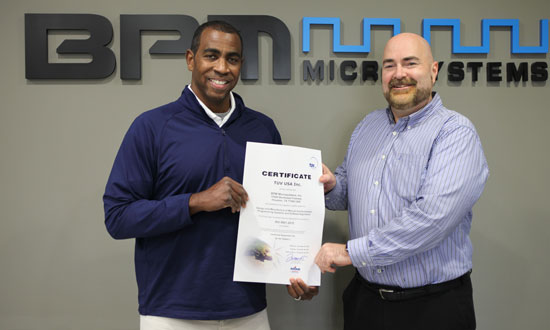
by Scott Bronstad | Mar 5, 2019 | News
EINPresswire.com — BPM Microsystems, a leading global provider of device programming systems for test and measurement systems, factory integration software, and solutions for the semiconductor and electronics industries, was awarded their ISO 9001:2015 Certification on December 9, 2018. Reggie Fields, BPM’s Director of Quality & Customer Experience says, “ISO 9001:2015 Certification is a huge accomplishment by our company. Document control within the automotive industry is challenging, and because BPM Microsystems manufactures all our systems, software, and algorithms right here in Houston, Texas, we can provide a total end-to-end solution few companies can match. The audit and certification were completed with hardly a bump along the way. I’m excited about the continuous improvement efforts our team is engaging in to continue being a world-class supplier meeting all the requirements of our tier one automotive OEM customers.”
Bill White, Founder and CEO of BPM says, “This is a perfect example of a stretch goal. There was no certainty it was even possible to complete certification last year. Many people on the outside suggested we would need another six months, but we set the goal and we accomplished it! This will be important news to our automotive customers who have a hard requirement for their suppliers to be ISO certified.”
The certificate was awarded by TUV USA Inc. and is in effect for the next three years. TUV USA, Inc. is one of the most experienced companies in assessing and certifying management systems and regulatory inspection activities in the US. All auditors are industry certified and have more than 15 years of industry knowledge and auditing experience.
Founded in 1985, BPM Microsystems serves more than 2,000 companies in over 40 countries, including programming centers, original equipment manufacturers (OEM), contract and semiconductor manufacturers. As a vertically integrated supplier with control over the manufacturing, software and global support, BPM programmers offer high-performance device handling, advanced serialization, and quality control, meeting the highest programming and cybersecurity standards for automotive, aerospace, medical, industrial and mobile device applications.
See original press release here
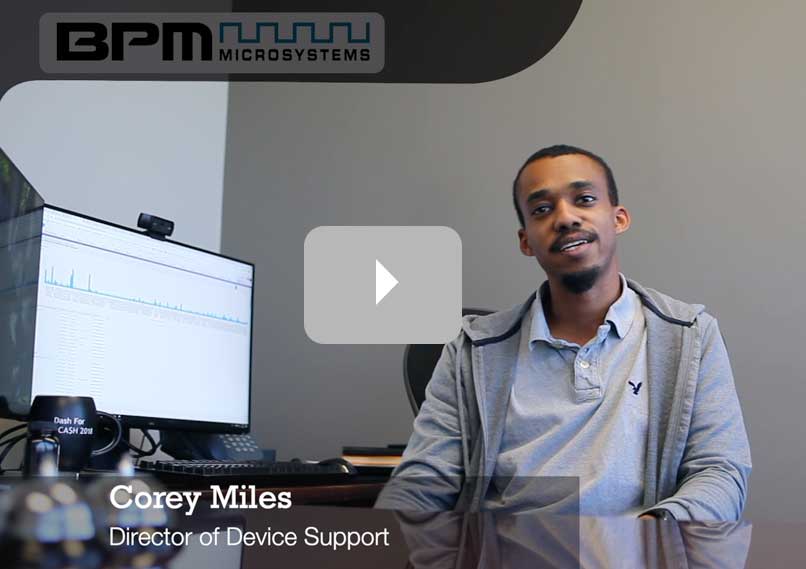
by Scott Bronstad | Feb 25, 2019 | News, Video
BPM Microsystems Device Support Update
Corey Miles, BPM Microsystems’ Director of Device Support, talks about some of the challenges in Device Support, what’s being done to address them, and what you can expect moving forward
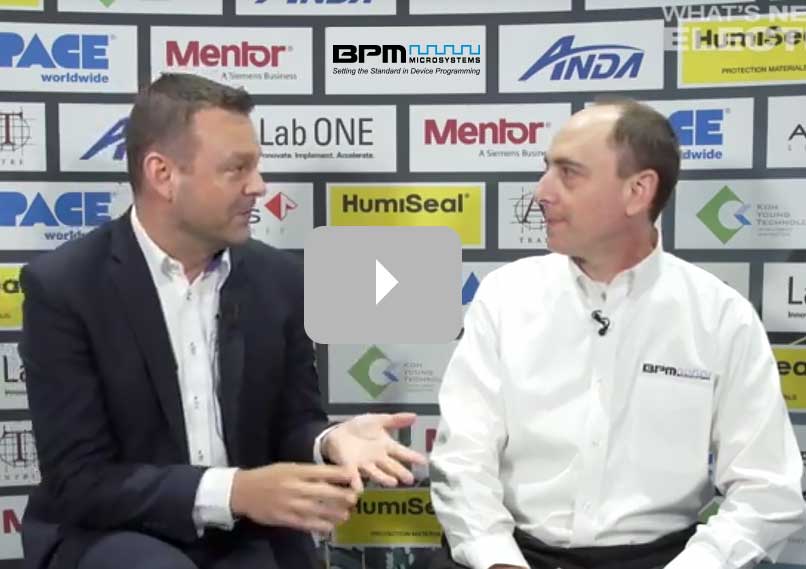
by Scott Bronstad | Feb 15, 2019 | News, Video
James Holava’s Conversation with WNIE-TV
Kim Sauer with “What’s New in Electronics” TV interviews James Holava, Global Sales Director with BPM Microsystems. Filmed on location at IPC APEX 2019 in San Diego, January 30, 2019.
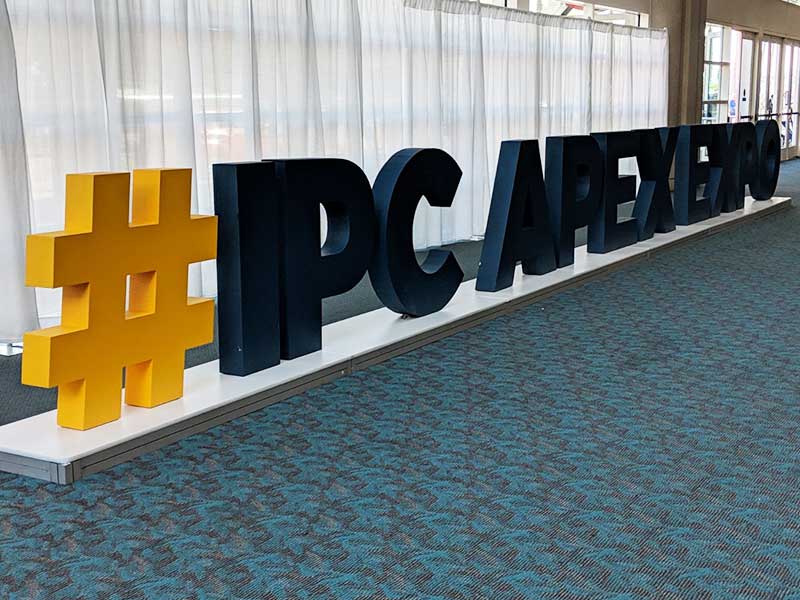
by Scott Bronstad | Feb 6, 2019 | Events, News
If you’re into cool gadgets, APEX 2019 was like a techie’s Christmas. BPM brought its coolest new machines and rocked it! Trade shows are a lot of work, and lots of things can go wrong (and they did), but fortunately, everything was running like a top by Tuesday morning. Here are the highlights and some more pics:
- NPI Award for WhisperTeach+ (if you bring back an NPI award in your carry-on luggage, it will flag a security check)
- Over 150 guests (that we know about) over 2-1/2 days
- Two video interviews (with Global SMT and What’s New in Electronics). Links coming soon
- Many opportunities discovered and a few rekindled
- The 3910 and 4910 Automated Programming Systems demonstrated why they are the best solution for Automotive, Industrial, IoT, Medical, etc. device programming— they truly are fast and easy (and profitable!)
- An 8-foot video wall provided some additional buzz
- Most of our Sales Representative Organizations covering the US, Canada, and Latin America participated, including InterLatin, the Murray Percival Group, and Restronics Inc.
- Quote of the week: “Your booth is amazing– so much traffic; you must have sexy machines!” from our next-door neighbor from Parker Hannifin
The 3910 was a hit (again) with its small footprint and big output
InterLatin, our sales organization in Mexico, was instrumental in engaging their connections to see what makes BPM different
It was great to show off fast and easy solutions to device programming
Game controller in hand, get your game face on for the WhisperTeach Challenge
A rare moment– only a few folks in the booth
David Roy, Region Sales Manager for US/Canada, talks about the advantages of programming with BPM
We made some great connections (and some new friends) at APEX ’19
James “Jim” Holava, Global Sales Director, participated in several interviews during APEX
Behind the scenes during a video interview at APEX on day 2
Check out https://www.wnie.online
The 4910 was flying fast and causing a stir at APEX ’19
Armando Garcia, Regional Sales Manager for Latin America, discusses opportunities with his team from InterLatin
APEX ’19 was definitely not boring!
William White (center), founder and CEO of BPM meets with several of our sales organizations, such as the Murrey Percival Group
Our booth was not ideally located, but we still managed to have tremendous traffic… must be something to see
The 2019 NPI Award for Production Software (two years in a row!)
The San Diego Convention Center is next to the Gaslight District, the historic heart of San Diego, filled with shops, bars and restaurants
The view from the Convention Center overlooking Coranado Island
The Convention Center in San Diego


 BPM launched two major product enhancements in 2018 with the 3910 in September and the 4910 in November at Electronica in Munich, Germany. The 3910 and 4910 feature WhisperTeach, the award-winning Z-Teach hardware/software that delivers faster set-ups, better accuracy, and repeatable high-quality programming, critical for modern devices. The machines also received a major increase in speed: The 3910 is rated at 1,432 Devices per hour with up to 16 sockets (44% faster than the 3900), while the 4910 delivers 1,708 DPH with up to 48 sockets (almost 30% faster than the 4900).
BPM launched two major product enhancements in 2018 with the 3910 in September and the 4910 in November at Electronica in Munich, Germany. The 3910 and 4910 feature WhisperTeach, the award-winning Z-Teach hardware/software that delivers faster set-ups, better accuracy, and repeatable high-quality programming, critical for modern devices. The machines also received a major increase in speed: The 3910 is rated at 1,432 Devices per hour with up to 16 sockets (44% faster than the 3900), while the 4910 delivers 1,708 DPH with up to 48 sockets (almost 30% faster than the 4900).
 BPM Microsystems is pleased to announce the addition of Don McMahan as their Global Sales Consultant. McMahan has a history of successfully growing sales through channels for companies large and small and was named one of CRN’s Top Channel executives four years in a row. “I am thrilled to join the management team at BPM, a company with a long legacy of delivering leading-edge solutions to some of the largest programmable semiconductor users in the world. It’s also very rewarding to join a US manufacturer that can compete on the world’s stage,” says McMahan.
BPM Microsystems is pleased to announce the addition of Don McMahan as their Global Sales Consultant. McMahan has a history of successfully growing sales through channels for companies large and small and was named one of CRN’s Top Channel executives four years in a row. “I am thrilled to join the management team at BPM, a company with a long legacy of delivering leading-edge solutions to some of the largest programmable semiconductor users in the world. It’s also very rewarding to join a US manufacturer that can compete on the world’s stage,” says McMahan.



